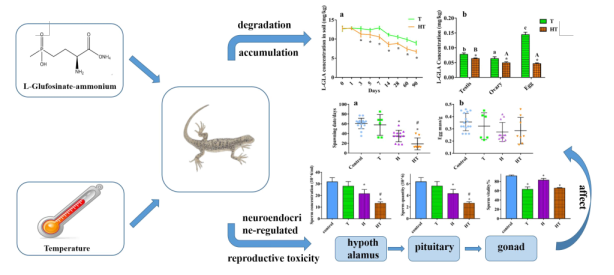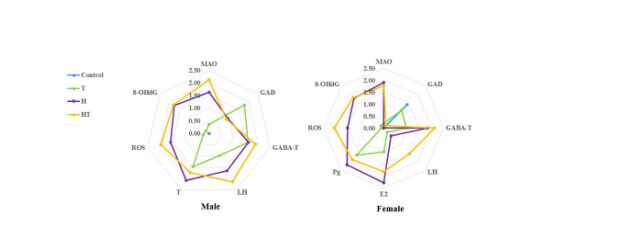上海酶联文献 :
Manuscript Details ENVPOL_2019_3670
Manuscript number Effects of L-Glufosinate-ammonium and temperature on reproduction controlled by neuroendocrine
Title system in lizard (Eremias argus)
Article type
Research Paper
Abstract
In the context of global warming, an important issue is that many pesticides become more toxic, putting non-target organisms at higher risk of pesticide exposure. Eremias argus, a native Chinese lizard, was selected as research organism in present study, because of their characteristics that poikilothermic vertebrate are sensitive to temperature change. The experimental design [(with or without L-Glufosinate-ammonium (L-GLA) pollution × two temperatures (25 and 30 °C)] was used in this study for 90 days to identify the chronic effects of the pesticide–temperature interaction on neuroendocrine-regulated lizard’ reproduction.
Survival rate, body weight, clutch characteristics, semen quality, testicular histopathology, the content of neurotransmitters and related enzyme activity, the level of sex steroid, the expression of Heat shock protein 70 (HSP70), antioxidant system, the accumulation and degradation of L-GLA were examined. Results showed that L-GLA disrupt reproduction of lizards through hypothalamus-pituitary-gonad (HPG) axis. In addition, temperature can not only change the environmental behavior of pesticides, but also alter the physiological characteristics of lizards. Thus, our results emphasized that temperature is an essential abiotic factor that should not be overlooked in ecotoxicological studies.
Keywords Eremias argus; L-glufosinate-ammonium; temperature; reproductive disruption; hypothalamus-pituitary-
Corresponding Author gonad axis
Corresponding Author's Institution Jinling Diao
Order of Authors China Agricultural University
Suggested reviewers Lu yao Zhang, Li Chen, Zhi yuan Meng, Ming Jia, Rui sheng Li, Sen Yan, Si nuo Tian, ZhiQiang Zhou,
Jinling Diao Xin Wang, Michael Butler, meirong zhao, Umesh Rai, Huili Wang
Submission Files Included in this PDF
File Name [File Type]
Cover letter.docx [Cover Letter]
Highlights.docx [Highlights]
graphical abstract .tif [Graphical Abstract]
manuscript.docx [Manuscript File]
Conflict of interest.docx [Conflict of Interest]
supporting information.doc [Supplementary Material]
To view all the submission files, including those not included in the PDF, click on the manuscript title on your EVISE Homepage, then click 'Download zip file'
Cover letter

Integrated Biomarker Response (IBR)
1. The detailed method of IBR calculation
The calculation is based on five major steps: (1) Biomarker data for all treatment groups were normalized with the control. (2) Calculate the standardisation of the mean value of each biomarker obtained for a condition, called X, using the mean value for all conditions (m) and the standard deviation for all conditions (s) to produce a value called Y: Y=(X-m)/s. (3) After this standardisation, we computed the Z value; Z = Y or Z = -Y whether an activation or an inhibition of the biomarker was expected in response to a contamination. (4) The value S was finally computed, with S = Z+|Min|, where Min is the minimal value observed for all exposure conditions for each biomarker, and finally plotted on a radar diagram. These S values thus represent the gradient of values for each biomarker in the different exposure conditions, with highest values corresponding to the highest biological effects. (5) The IBR corresponds the total area displayed by the radar diagram. Larger area indicates stronger biomarker responses and more serious the impact of chemicals on the organism.
2. The result of IBR
A common challenge in multibiomarkers studies is to go beyond an independent interpretation of each one, and to really assess an overall response. Therefore, IBR including neurotransmitters-related enzyme (MAO, GAD, and GABA-T), gonadotropin and sex steroids (T, E2, and Pg), andantioxidant system (ROS and 8-OHdG) were calculated and shown in Figure. S8 and the IBR score are listed in Table S5. Whether in the male or female, IBR value (radar diagram area) in the
HT group is much larger than that in the T group. Larger area indicates stronger biomarker responses and more serious the impact of chemicals on the organism [6]. Thus, our founding suggest that thermal stress aggravated the reproductive toxicity of L-GLA to lizards.

Fig. S8. Star plots for biomarker responses in male and female lizard. (MAO = monoamine oxidase; GAD = glutamic acid decarboxylase; GABA-T = gamma-aminobutyric acid transaminase; T = testosterone; E2 = estradiol; Pg = progesterone; ROS = reactive oxygen species; 8-OHdG = 8-hydroxy-2 deoxyguanosine).














